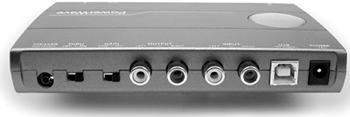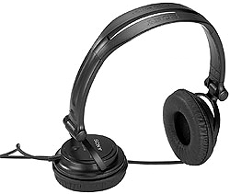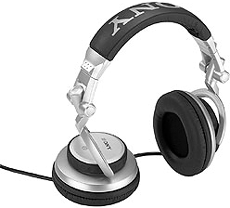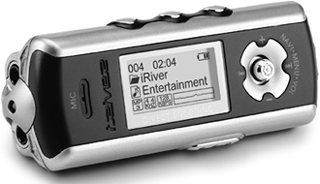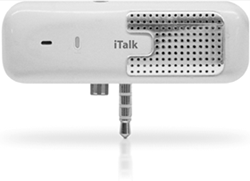Equipment
| One great thing about podcasting is that you can do it at home with a basic Mac or PC and an inexpensive microphone (which may come with the computer). High-end equipment is nice, to be sure, but many of the best podcasts out there are recorded and edited with basic equipment and widely available software. Still, there are several ways to set up a podcast recording "studio," from using nothing more than a computer with a microphone to having high-end microphones, preamps, digital recorders, and the like in a sound-dampened room. For serious podcasters, the list of necessary equipment is as follows:
This section examines the equipment you need to get up and running (software is covered a little later on). I need to point out that many devices that can make podcasting easier or higher quality, but I cannot cover every one of them in this book. Instead, I examine several key pieces of equipment in each category. MicrophonesArguably the most important device in the creation of a podcast, the microphone stands between your voice and the podcast file. As such, it behooves you to ensure that the quality of the recording is as good as it can be based on your budget and expectations. Two main types of microphones are used for podcasting: condenser microphones and dynamic microphones. Condenser microphones use a capacitor to capture sound. This works when the pressure from the sound changes the space between the thin membranes in the capacitor. The advantage of a condenser microphone is that it has a very broad frequency response; the down side is that it requires a source of power (like a battery) to charge the capacitor so that it can work.
Dynamic microphones work by measuring the movement of a wire coil around a magnetic field as the sound waves agitate the wire. The advantages of a dynamic microphone are that it is cheaper to make than a condenser microphone and can be miniaturized more easily.
The down side is that the frequency response isn't as good as that of a condenser microphone, making the sound quality inferior.
If the frequency response (quality of sound) is important to you, I recommend a condenser microphone. Most microphones that come with computers are dynamic microphones, and although they are acceptable, you will eventually have to purchase a quality microphone if you want your podcasts to sound professional. Behringer C-1Frequency Response: 40 Hz 18,000 Hz Power: Phantom The Behringer C-1 (Figure 3.4) is a professional-quality condenser microphone that uses a cardioid pattern to accept sound. At around $55, the C-1 is an outstanding microphone for the beginning, intermediate, or even expert podcaster. The real bonus is that the quality is high but the price is surprisingly reasonable for a product of this caliber. Figure 3.4. The Behringer C-1 condenser microphone is an awesome value and can more than do the job.
(Photo © Copyright 2005. BEHRINGER Spezielle Studiotechnik GmbH.) Electrovoice 635AFrequency Response: 40 Hz 18,000 Hz Power: Phantom The Electrovoice 635A microphone (Figure 3.5) is probably the best-known microphone in the TV and radio business. A very dependable (some would say nearly indestructible) microphone, the 635A is a mainstay in the radio business and will serve any podcaster well, especially if recording on the road is in the cards. Figure 3.5. The Electrovoice 635A is a mainstay micro phone and, according to Tod Maffin, is the "best microphone you can buy when starting out."
Stageworks CC12Frequency Response: 40 Hz 18,000 Hz Power: Phantom The Stageworks CC12 (Figure 3.6) is a more-than-suitable condenser microphone that is comparable to the Behringer in many ways. The CC12 uses a supercardioid pattern to accept sound and, as such, produces very clear sound capturing. Although it lists at $99, the Stageworks CC12 condenser microphone is widely available for around $50. Figure 3.6. Like the Behringer microphone, the Stageworks CC12 offers high quality for a low price.
MC01 Professional Condenser MicrophoneFrequency Response: 30 Hz 16,000 Hz Power: Phantom The MC01 (Figure 3.7) is the microphone for the high-end user (relatively speaking). At $180, the MC01 is designed for studio use and can be used to record both voices and musical instruments. The MC01 comes with a shock-mount system and a carrying pouch that makes it easy to tote around. Figure 3.7. The MC01 Professional Condenser Microphone is my choice for a high-end microphone.
Audio Technica ATM73A-SPFrequency Response: 25 Hz-17,000 Hz Power: Battery This headset cardioid condenser microphone is best used by those who want to create podcasts as a one-man (or one-woman) show. At $120, the ATM73A-SP (Figure 3.8) isn't inexpensive, but it is a high-quality microphone that you can clip to your head so that you don't have to worry about being directly in front of it all the time. Figure 3.8. A headset-based cardioid condenser microphone is a great choice for a lone podcaster.
DT 234 PRO HeadphoneFrequency Response: 20 Hz 18,000 Hz Power: Phantom This headset cardioid microphone costs around $99. Made by Industrial Audio Software, the DT 234 (Figure 3.9) contains a dynamic transducer, meaning that the quality is ultimately not as robust as that of a con denser microphone. That said, the DT 234 is a comfortable and reasonable performer best used by podcasters who do their work alone and don't have to share their microphones frequently. Figure 3.9. The DT 234 headset-based cardioid dynamic microphone
Logitech USB Headset 200Frequency Response: 100 Hz 16,000 Hz Power: USB port Priced around $45, the Logitech Stereo USB Headset 200 (Figure 3.10) is a good choice for those who are willing to forgo the highest sound quality in exchange for mobility and ease of use. The Headset 200 plugs into the USB port of your computer and is easy to set up. The microphone is a dynamic noise-canceling device that strives to filter out background noise. The result can be a mellowing of the user's voice, but it is a small price to pay, considering what you are getting for your money with this product. Figure 3.10. A low-cost but effective headset microphone, the Logitech USB 200 is a solid option.
Labtec Desk Mic 534Frequency Response: 100 Hz 16,000 Hz Power: 1.5 V DC (supplied through connector cable) I include this microphone because it is a very common device that is included with many PC computer bundles. As a result, many readers may already have this microphone sitting on their desk. Although it's not a high-end condenser microphone, the $14.99 price tag makes it an excellent choice for those on a budget. Apple Computer built-in microphonesFrequency Response: Varies Power: Internal Many Apple computers come with a built-in microphone. iMacs have a microphone in their screen, and many older Macs come with an external microphone that can be plugged in. Although these microphones do not offer super-high quality, and although there can be some issues with the computer's fan sound getting picked up, these built-in microphones can do the job in a pinch.
Audio interfaces/preampsMany of the microphones mentioned in this chapter require phantom power that is, they require a device to supply power to them so that they can work. These devices can't be plugged straight into the computer; instead, they must be connected to a preamp device that acts as an input controller between the sound input devices and your computer. Although these devices add another layer of cost to your podcast setup, they are not terribly expensive, and they also allow access to several extra features you probably didn't even consider. Preamps offer the ability to input any sort of sound into your computer, including inputs from a musical instrument (like an electric guitar) or even inputs from an old eight-track tape that you want to convert to an MP3 file. In short, a preamp computer device allows the input of virtually any kind of audio signal. For everything from making podcasts to recording an acoustic guitar track for GarageBand (a music-creation program for the Macintosh computer), a preamp is a wise investment. Behringer Tube Ultragain MIC200
Figure 3.11. The Behringer MIC200 is a solid preamp that uses old-fashioned vacuum-tube technology.
Griffin iMic
Figure 3.12. The iMic is a low-cost, yet effective, solution.
The benefit of USB audio input devices (preamps) comes from the fact that the inputs are isolated from any electronic "noise" that might otherwise be picked up from a computer's sound card. How much of a difference a USB device makes isn't entirely clear, but in the case of the iMic, it works like a charm. XPSound XP-202
Figure 3.13. The XP-202 is the high-end preamp for podcasters who want the best.
At $199, this is not the inexpensive alternative, but for anyone who wants more control of the sound input process, the XP-202 is the right machine for the job. The feature list includes:
M-Audio MobilePre USB
Figure 3.14. The M-Audio MobilePre USB is a solid preamp for both the Mac and PC.
Although designed specifically for use on laptops in mobile situations, this little preamp is plenty powerful enough to sit proudly in any home studio.
PowerWave USB
Figure 3.15. The PowerWave USB is Griffin Technology's high-end audio input device.
HeadphonesHeadphones can be considered a luxury, but when it gets down to brass tacks, you will quickly find that a decent pair of headphones is more of a necessity. You cannot monitor the podcast during the actual recording unless you have headphones, for example. If the podcast were playing back through your computer's speakers as you were recording it, a noisy feedback buzz would be the result. For this reason, it is important to get a pair of headphones that is at the very least comfortable for you to have on your head while creating your podcasting masterpiece. This section suggests several quality headphones for your consideration, but ultimately, any headphone that you are comfortable with will do. If you already own headphones even MP3 player headphones they will do the trick. There are literally hundreds of headphone models out there, so all I can recommend is that you use a set that sounds good to you and is comfortable. Of course, if you already are using one of the microphones with attached headphones, you can skip this section. Sony MDR-V150 HeadphonesAt $19.99, these MDR-V150 headphones (Figure 3.16) are a quality yet inexpensive option from a well-known manufacturer. They are comfortable over-ear headphones with 30mm drivers and ferrite magnets for exceptional response (for the price). Figure 3.16. Despite being a very basic set of headphones, the Sony MDR-V150 model is good enough for the beginner.
Sony MDR-V700DJ HeadphonesThese are a midlevel set of headphones from Sony. The sound quality of the MDR-V700DJ headphones (Figure 3.17) is noticeably better than that of the cheaper Sony 'phones, so for those who insist on high fidelity, these are a great choice. The V700DJ is a disk-jockey model with swivel ear cups, allowing the wearer to flick the ears over to permit conventional hearing. Many podcasters like this feature when they are engaging in an interview (they like to have one of their two ears exposed). At $149.99, these headphones aren't cheap, but the sound-fidelity difference is noticeable. Figure 3.17. These DJ headphones feature swivel ear cups.
JVC HA-G55 HeadphonesThe JVC HA-G55 headphones (Figure 3.18) are a middle-of-the-road choice priced at $55. With a frequency response of 12 Hz to 25,000 Hz, they are capable of delivering a wide range of sounds to your ears. The advantage of the HA-G55s is that they have full-size, deep-base ear cups that allow for a rich sound that encircles the listener. These headphones are another excellent choice. Figure 3.18. Priced between the two Sony models mentioned earlier in this section, the JVC HA-G55 headphones are a quality option.
Digital recordersAlthough it may be tempting to rush out and purchase a digital recorder for your podcast needs, I need to point out that your computer itself is a powerful digital recorder, and the need for one of these devices is certainly not critical as long as you have a Mac or Windows PC. Still, digital recorders do have a certain amount of je ne sais quoi that makes them more glamorous. Of course, there are legitimate reasons to get a digital recorder, not the least of which is the portability these devices afford the user. A digital recorder allows you to record programs virtually anywhere, provided that you have a microphone (some digital recorders have built-in microphones) and power to drive the unit. The only limitation with a digital recorder is its memory size; high-quality digital recordings take up a lot of memory space, so the size of the memory in a recorder is the main limiting factor when it comes to recording. In this section, I take a look at three digital-recorder options: a high-end digital recorder, a midrange MP3 player option, and an iPod using Griffin Technology's iTalk microphone. The digital-recorder market offers plenty of choice, and it isn't within the scope of this book to examine them all, but taking a look at the cost and features of several units can help fill in the blanks about digital recorders and the need (or lack thereof) to own one.
Edirol R-1
Figure 3.19. The Edirol R-1 is one example of a high-end digital recorder.
The feature list of this product is very impressive:
Clearly, the Edirol R-1 is a full-featured digital recorder that exceeds the needs of most podcasters. For anyone who is looking to become a serious podcaster, the Edirol is worth considering. Its many built-in features, the high quality of its recordings, and its portability make it a very popular choice. iRiver IFP-795
Figure 3.20. The iRiver IFP-795 is an amazingly functional digital recorder that masquerades as an MP3 player.
Because the iRiver comes with software that allows easy connectivity to PCs or Macs, its USB 2.0 connection makes connection and export of recorded files a breeze. The device supports recording bit rates between 8 Kbps and 320 Kbps in WMA, MP3, and OGG music formats. Apple iPod with Griffin iTalk
The iTalk (Figure 3.21) is an ingenious device that attaches cleanly to the top of the iPod, and after you install the software (which is easy to do), the iPod becomes a competent voice recorder. The iTalk comes with a built-in speaker that allows you to record without any other equipment, but if quality is your goal, I suggest plugging an external microphone into the iTalk. Figure 3.21. The iTalk is a mobile-recording option for iPod users.
The iTalk is a nifty little unit that will record on the iPod's hard drive in .WAV file format. When the iPod docks with iTunes, the file will be transferred to iTunes automatically, making it easy to pull off for editing. The device does have a down side, in that the user cannot change the recording bit rate. Also, the quality of the built-in speaker, although decent, is not exactly broadcast quality. Still, as a portable recording device, the iTalk is an inexpensive ($49) option for an iPod owner.
|
EAN: N/A
Pages: 80












